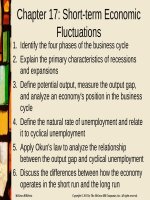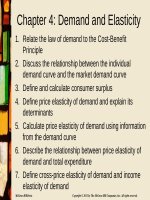Lecture Principles of economics (Asia Global Edition) - Chapter 5
Bạn đang xem bản rút gọn của tài liệu. Xem và tải ngay bản đầy đủ của tài liệu tại đây (914.41 KB, 40 trang )
Demand
Chapter 5
McGrawHill/Irwin
Copyright © 2015 by McGrawHill Education (Asia). All rights reserved. 51
Learning Objectives
1.
2.
3.
4.
5.
Relate the law of demand to the Cost-Benefit
Principle
Discuss how individual wants are translated into
demand
Explain the reasoning behind the rational spending
rule and apply it to consumer decision making to
show how the rule is related to substitution and
income effects
Discuss the relationship between the individual
demand curve and the market demand curve
Define and calculate consumer surplus
52
Free Ice Cream – Or Is It?
•
The cost of a good extends beyond its monetary
cost
–
–
–
•
•
Waiting in line
Purchasing a permit
Participating in a lottery
"Free" ice cream attracts so many consumers
that the time spent waiting in line acts as the
price of the good
Demand curves relate the quantity demanded to
ALL costs, not just monetary costs
53
Law of Demand
Law of Demand
People do less of what they want to do
as the cost of doing it rises
54
Law of Demand
•
Cost-Benefit Principle at work
–
•
Do something if the marginal benefits are at least
as great as the marginal costs
An increase in the market price approaches our
reservation price
–
–
If market price exceeds the reservation price, buy
no more
Costs include ALL costs – money, time, reputation
•
Consider implicit and explicit costs
55
Origins of Demand
•
Reservation price
–
Individual tastes and preferences differ
§
§
§
–
Tastes may change over time
•
•
•
Biological needs
■ Cultural influences
Peer behavior
■ Individual differences
Perceived quality
■ Expected benefits
Hamburger and donut
Pearl milk tea
New goods get incorporated into priorities
56
Needs versus Wants
•
Some goods are required for subsistence
–
•
Beyond subsistence, behavior is driven by wants
–
–
•
These are needs
Rice or noodle
Hamburger or chicken sandwich
Wants depend on price
–
Water in Tokyo
•
Regulations or price mechanism
–
–
Regulations are cumbersome and expensive
Price changes are fast and effective
57
California Water Shortages
•
•
Problem: California has a large population and
relatively low annual rainfall, so some argue that
water shortages are inevitable
Analysis
–
–
–
New Mexico has less rainfall per person and fewer
shortages
California's water price is low
Low price discourages careful use
•
•
Rice is grown because water is cheap
Water-intensive home landscaping
58
Wants and Demand
•
Unlimited wants
–
–
•
Limited resources
–
–
•
More things, better quality things
Services, including entertainment and travel
Money, income, and wealth
Time and energy
Prioritize wants
–
–
Allocate resources accordingly
Demand those things for which you are willing and
able to pay
59
Wants and Utility
•
Utility: the satisfaction people derive from
consumption
Well-being, happiness
Measured indirectly
–
–
•
•
–
•
Subjective
Observable
Cannot be compared between people
Individual goal is to maximize utility
–
Allocate resources accordingly
510
Sarah's Utility from Ice Cream
0
1
2
Total Utility
0
50
90
Utils/hour
Cones /
Hour
3
4
5
6
120 140 150 140
150
140
120
9
0
5
0
1
2 3
4
Cones/hour
5
6
511
Sarah's Marginal Utility from Ice
Cream
Cones /
Hour
0
1
2
3
4
5
6
Total Utility
0
50
90
120
140
150
140
Marginal Utility
•
50
40
30
20
10
-10
Marginal utility: the additional utility from
consuming one more
Change in utility
Marginal utility =
Change in consumption
512
Diminishing Marginal Utility
Law of Diminishing Marginal Utility
Tendency for additional utility gained
from consuming an additional unit of a good
to decrease as consumption increases
beyond some point
513
Diminishing Marginal Utility
•
Marginal utility can increase at low levels of
consumption
First unit stimulates your desire for more
–
•
•
•
Eventually marginal utility declines
–
•
First MP-3 player in a 5-person household
First potato chip
Continue consuming
Apply Cost-Benefit Principle
–
Consume an additional unit as long as the marginal
utility (benefit) is greater than the marginal cost
514
•
Assume a fixed budget
Decide how much of each
good to buy
•
Law of Diminishing
Marginal Returns applies
–
–
As you buy more of a single
good, its marginal utility
decreases
When you buy less of that
good, its marginal utility
increases
Marginal Utility
•
Marginal Utility
Spending on Two Goods
515
Budget Allocation
•
•
Maximize utility when the marginal utility per
dollar spent is the same for all goods
No Money Left On the Table Principle
Current spending has marginal utility of a dollar spent
on one good higher than the marginal utility of a
dollar spent on the other good
Take a dollar away from the good with low marginal
utility and spend it on the good with high marginal
utility
–
–
•
Marginal utilities per dollar begin to equalize
516
Sarah's Ice Cream
•
•
•
Chocolate is $2 per pint
Vanilla is $1 per pint
Buy 200 pints of vanilla
and 100 pints of
chocolate
•
Vanilla
Ice Cream
12
200
Pints/yr
Marginal utility is 12 for
vanilla, 16 for chocolate
MU (utils/ pint)
$400 budget
MU (utils/ pint)
•
Chocolate
Ice Cream
1
6
10
Pints/yr0
517
Sarah's Next Step
•
Reduce chocolate by 50
•
•
Marginal utility of vanilla is 8
Marginal utility of chocolate
is 24
Vanilla
Ice Cream
12
8
20
Pints/yr
0
30
0
MU (utils/ pint)
Increase vanilla by 100
MU (utils/ pint)
•
2
4
Chocolate
Ice Cream
1
6
50 10
Pints/yr0
518
Sarah's Equilibrium
•
Marginal utility / price is
the same for all goods
•
Marginal utility of vanilla
10, chocolate 20
Vanilla
Ice Cream
MU (utils/ pint)
•
Optimal combination:
highest total utility
250 pints vanilla; 75 pints
chocolate
MU (utils/ pint)
•
10
25
Pints/yr 0
Chocolate
Ice Cream
2
0
75
Pints/yr
519
Sarah's Choices
Scenario
1
Vanilla
Chocolate
Scenario
2
Vanilla
Chocolate
Scenario
3
Vanilla
Chocolate
Price
Quantity
$1
200
Marginal
Utility
12
$2
100
16
Price
Quantity
$1
300
Marginal
Utility
8
$2
50
24
Price
Quantity
$1
250
Marginal
Utility
10
$2
75
20
MU / $
12
8
MU / $
8
12
MU / $
10
10
520
Rational Spending Rule
The Rational Spending Rule
Spending should be allocated across goods so that
the marginal utility per dollar
is the same for each good
521
Rational Spending Rule
•
•
Rational Spending Rule can be written
algebraically
Notation
–
–
–
–
•
•
MUC is the marginal utility from chocolate
MUV is the marginal utility from vanilla
PC is the price of chocolate
PV is the price of vanilla
Rational Spending Rule
MUC / PC = MUV / PV
The marginal utility per dollar spent on chocolate
equals the marginal utility per dollar spent on
vanilla
522
Substitution Effect
•
When the price of a good goes up, substitutes for
that good are relatively more attractive
–
–
At the higher price less is demanded because some
buyers switch to the substitute good
If the price of vanilla ice cream goes up, some buyers
will buy less vanilla and more chocolate
523
Income Effect
•
Changes in price affect the buyers' purchasing
power
Acts like a change in income
–
•
Suppose vanilla ice cream goes from $1 per pint
to $2
If Sarah spends all her income on vanilla, the amount
she can buy goes down by half
At the original prices, she could buy 100 pints of
vanilla and 150 pints of chocolate
–
–
•
At new price for vanilla, she buys 100 vanilla and only
100 chocolate
524
Rational Spending and Price
Changes
•
•
•
Suppose price of vanilla increases from $1 to $2
At the original equilibrium
MUC / PC = MUV / PV
With the increase in PV, MUV / PV < MUC / PC
If Sarah buys more chocolate, MUC will go down
If Sarah buys less vanilla, MUV will go up
To get to a new optimal spending point,
–
–
–
•
•
•
Buy more chocolate
Buy less vanilla
Stop when the marginal utility per dollar is the same
525









